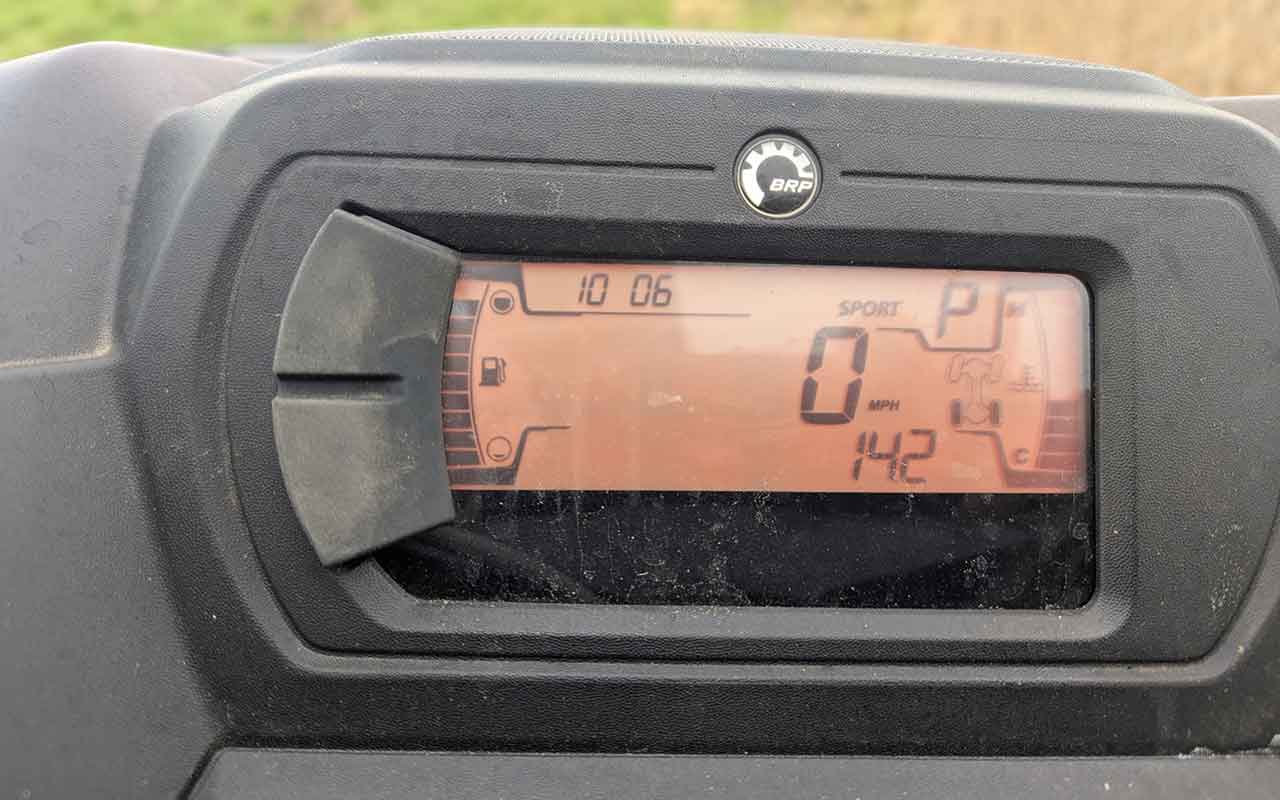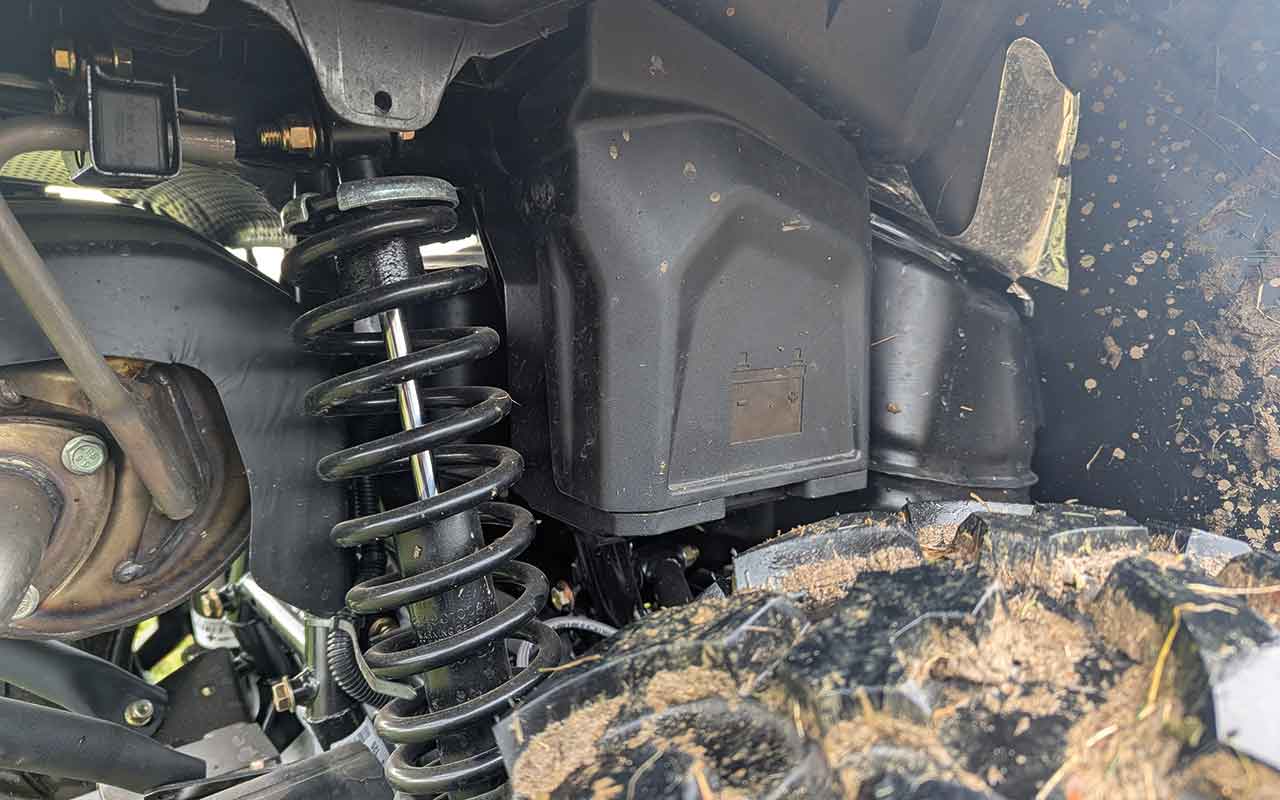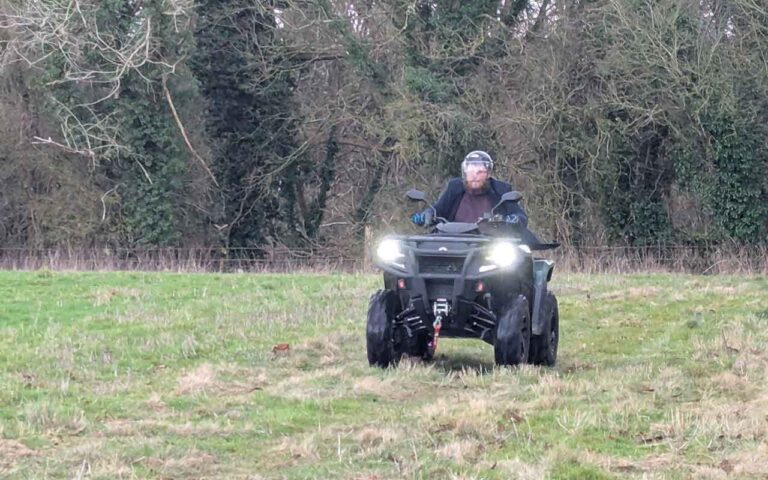The new Outlander Pro HD7 XU comes with a series of improvements over the previous generation of machines.
Walking around the machine with Turney’s Dave Vear, he started with the single-cylinder Rotax engine, with a displacement of 650cc, pushing out 50hp.
This is 10hp over the slightly smaller HD5, both of which run through a continuously variable transmission.
On the HD7, this gearbox can reach 100kph, or around 60mph, with high and low ranges to limit the speed and three driving modes that can be activated using switches on the handlebars.
Intelligent engine braking comes as standard on the XU model, with the ability to adjust how aggressive the system is.
Also fitted on the XU over the standard model is dynamic power steering, again with three modes of aggressiveness to suit the speed and conditions.
Ignition update
Dave highlighted that the ignition had been swapped out for a digitally encoded plastic fob, which must be inserted into the slot for the machine to start.
“I know a lot of users who attach a lanyard to the fob, so that if you were to fall off the machine, it would be pulled out and act as a kill switch,” he said.
There’s a clear advantage to this, given the poor safety record in agriculture and especially around ATVs, and it would be nice to see a system like this included as standard in future.
“Another advantage of the fob system is that it’s completely sealed,” he added. “Sometimes water and dirt could get into the ignition, which would cause a lot of unnecessary maintenance.”
Ease of maintenance was clearly a priority with the upgrades, with the battery moved to the right rear wheel arch for easier access – although with the added risk of dirt ingress or damage.
By doing this, users and technicians can not only get to the battery, but also access the engine under the seat.
Designed to be a workhorse, the HD7 XU has a front capacity of 54.4kg and a rear rack capacity of 109kg, with a towing capacity of 830kg, making it ideal for delivery materials to difficult-to-reach areas on farm.
From the near-endless list of options there are also a few creature comforts available. Dave said the most popular option is the heated handlebar grips, perfect for cold mornings, although best practice would see operators wearing gloves when using an ATV.
Another neat option is the ability to swap out the USB charging ports – another possible avenue for dirt and water ingress – for a wireless charging pad tucked away under the steering column.

Out in the field
Jumping on the seat, the acceleration was instant, and with a large, fairly flat field to tackle, we were quickly able to get the Outlander up to top speed.
To be honest, 60mph feels excessive off road, even on fairly smooth running, but the machine felt stable and the dynamic power steering adjusted itself in line with the forward speed so there were no sudden jerks to the left or right.
The suspension was also excellent, dampening a lot of the bumps as we sped up the headland, and we barely had to press the brakes when we wanted to slow down. Instead, releasing the accelerator activated the engine braking system, which quickly reduced the speed.
Dropping it into work mode, the speed was limited to about 40mph, and the acceleration backed off. While we didn’t have a trailer or any load to speak off – this editor notwithstanding – you could feel the power kept in reserve.
It certainly gave the impression that it could easily handle more extreme conditions, in the form of steeper inclines, more load or particularly muddy conditions.
Dave had warned us that the Rotax engine, while essentially ‘bullet-proof’, would run hot. If this was the case, it is well insulated, as at no point during the test did we feel the heat from the engine bay, which is directly under the operator’s seat.
The forward and reverse lever is a little bit clunky, occasionally requiring us to rock the machine to get in or out of gear. This wasn’t a major issue, as the transmission holds until the accelerator is pressed, but should be kept in mind.
After all, there’s always the risk that someone might catch the accelerator as they climb on or off the ATV – perhaps another reason to make a lanyard fob a standard feature.
It can be a bit confusing at first to change certain functions on the machine, with some sharing buttons with other features, and others having controls hidden out of sight when you’re sat on the machine.
However, the really important functions are self-explanatory and with the ATV out of gear, you can quickly get to grips with some of the functions, using the clear digital dashboard to help you navigate the controls.

Bargain upgrade
Dave noted that the HD 7 was by far the most popular model, far above the less-power HD5.
It’s not hard to see why, with prices starting at just over £9,200 for the Outlander XU range. Upgrading to the HD 7 costs about £800 – a bargain for the added speed and power.
And if you don’t always need that power and speed, or you have concerns about the safety of some operators, you can specify multiple encoded key fobs for the Outlander, with some set to work mode to limit the speed.
The Outlander HD7 XU is a fun, powerful machine to ride. This is both its greatest asset and its biggest flaw.
An ATV is more fun to drive than a UTV, but in all but the most extreme conditions it is far less practical if you need a genuine work vehicle.
Yes, the Outlander has rack storage and a decent towing capacity, but Can-Am’s base UTV, the Traxter, outshines the Outlander in this capacity and can be picked up for not a lot more money.


